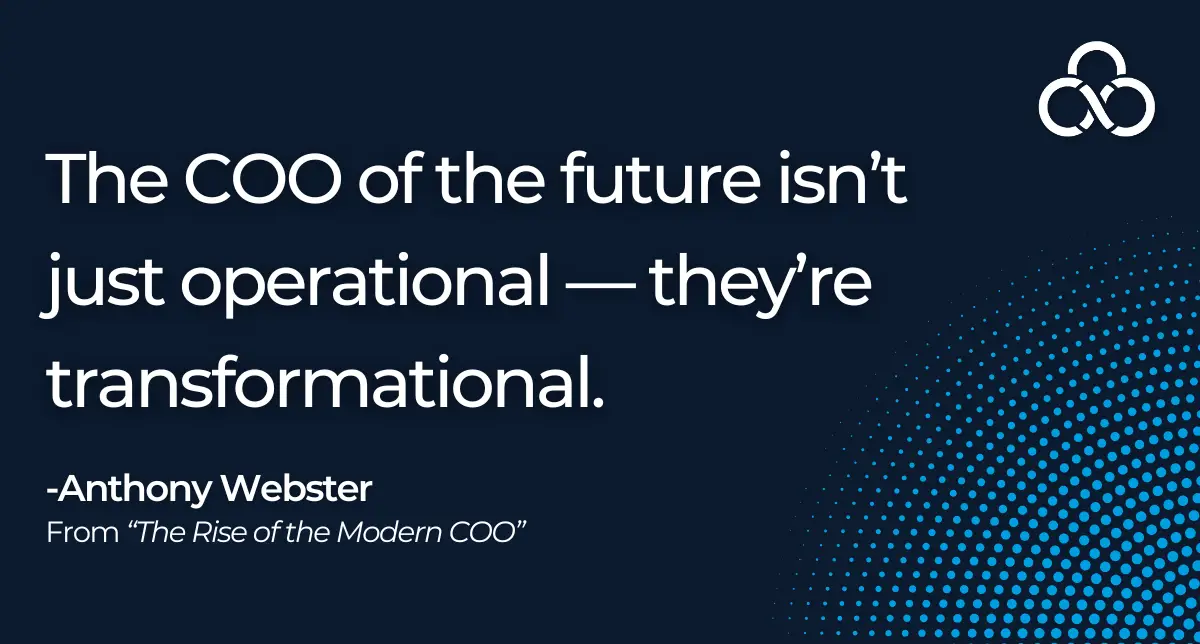
The Chief Operating Officer (COO) role has undergone a dramatic transformation over the past decade. Once viewed as the behind-the-scenes executor responsible for keeping the business running efficiently, the modern COO is now stepping into the spotlight as a driver of digital transformation, innovation, and future-fit strategy.
Today’s COO must be as comfortable talking cloud infrastructure and AI as they are discussing operational KPIs or supply chain optimisation. It’s no longer enough to be a safe pair of hands; now, it’s about being a visionary partner to the CEO and an orchestrator of innovation across the business.
The Evolving Role: What’s Changed?
Recent research shows that the traditional COO skillset is no longer sufficient in today’s climate of volatility, rapid technological change, and increasing customer expectations:
- 40% of leading companies now have a dedicated COO, up from 32% in 2018 – particularly in sectors such as financial services and insurance where operational resilience and digital capability are crucial (McKinsey, 2023).
- A Deloitte global COO survey found that while operational efficiency is still key, COOs are increasingly investing in innovation (10%), capacity expansion (14%), and sustainability (12%).
This shift reflects the rising complexity of modern organisations. COOs are now expected to lead on strategic transformation, harness emerging technologies, and even play a role in shaping culture and purpose.
Blending COO, CIO, and CTO Capabilities:
One of the most significant evolutions in the COO role is the increasing overlap with both CIO and CTO functions. As technology becomes the backbone of every operational decision, the lines between operations, IT, and tech strategy are blurring.
Today’s COO is expected to go far beyond process and performance. They must be a digitally fluent leader, capable of understanding and leveraging the full tech stack, from data and infrastructure to customer experience and automation.
In many organisations, this means the COO role is blending with or sitting alongside that of the CIO (Chief Information Officer) and CTO (Chief Technology Officer). In some cases, we’re seeing hybrid leadership roles emerge like Chief Transformation Officer, Chief Digital & Operations Officer, or even COO/CIO hybrids where one executive holds the mandate to drive operational excellence and deliver technology-led change.
This modern hybrid leader is expected to:
- Oversee digital transformation, including cloud adoption, automation, and enterprise systems.
- Understand emerging technologies like AI, data science, and cybersecurity—and how they impact business strategy.
- Collaborate cross-functionally with product, data, finance, and risk teams.
- Lead technology innovation and operational execution simultaneously, ensuring agility without losing control or oversight.
CTOs, once solely focused on the tech roadmap or engineering leadership, are now often partnering with or reporting into COOs as operations becomes more tech-enabled. In high-growth, innovation-led businesses, the COO may also act as the CTO in all but name, owning the full delivery of tech-backed customer experience and infrastructure change.
This fusion of responsibilities calls for a new breed of executive, a hybrid operator-technologist-strategist who can bridge the gap between boardroom vision and digital execution.
Talent Trends: What Clients Are Looking For
Having recently delivered a global COO search for a major insurer, I saw firsthand how priorities have shifted. This organisation wasn’t just looking for someone to streamline operations, they needed a modern leader who could drive tech-enabled transformation across global teams, embed agile ways of working, and future-proof the business against evolving customer demands and market disruption.
Our shortlist combined traditional operational excellence with strong digital credentials, including experience in scaling innovation teams and managing tech change across complex stakeholder landscapes.
Increasingly, the best COO candidates bring:
- A blended background across operations, digital, and transformation.
- Experience leading cross-functional global teams.
- Comfort with C-suite collaboration, governance, and strategic board-level engagement.
- An agile mindset, often with exposure to scale-ups, transformation environments, or digital-first businesses.
The Future COO: A CEO-in-Waiting?
There’s also a noticeable shift in how companies view the COO as a critical succession pipeline for the CEO.
Many of today’s most successful CEOs were former COOs, having built up a deep understanding of the organisation, customer journeys, and operational levers that drive growth and resilience.
To prepare for that level of responsibility, modern COOs need more than executional muscle.. They need strategic vision, stakeholder influence, and the ability to embed culture, purpose, and long-term thinking into their operations.
Closing Thoughts
The COO of today is no longer just the operational engine of the business, they are a strategic, digitally literate, innovation-oriented leader who plays a pivotal role in shaping the future of their organisation.
For companies looking to stay competitive and build resilience in 2025 and beyond, investing in the right COO hire could be the smartest strategic decision they make.
If you’re considering the future of your leadership team, reviewing succession plans, or thinking about how to bring fresh capability into your senior structure — now is the time to act.
Whether you're hiring now or planning ahead, I’d be happy to share insights from the market, discuss how other firms are structuring their leadership, or help you identify the right talent for your evolving needs.
Let’s connect and grab a coffee ☕



